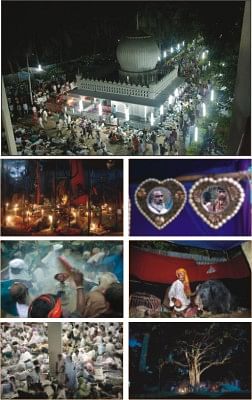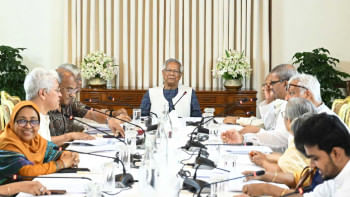A cornucopia of universal love

Photo: Mumit M.
...Sometimes they refer to the mela as ‘Lalon’ and at times address one another by that name. The rather melodic Kushtia pronunciation of ‘Lalon’ reverberates in the air.
Hundred and twenty years after Fakir Lalon Shai's demise, hundreds of thousands of people -- from ardent devotees to curious tourist types -- still gather at his akhra (den). This year's five-day Smaran Utshab (memorial festival) at the akhra in Chheuria, Kushtia was no different. People from all corners of the country attended the utshab, held from October 16 to 20. What were their respective purposes? Did they go there to learn about the tatwa (philosophies) of the mystic bard, to enjoy his everlasting songs, or just to catch a glimpse of this unique celebration?
Troupes of devotees started arriving at Chheuria a few days ahead of the utshab. Many were from Dhaka. There seemed to be a shortage of tickets for the Kushtia-bound buses from Dhaka. Urban enthusiasts might have had their individual visions of the festival, but mostly they shared a common interest -- impassioned renditions of Lalon songs that satiate souls.
One could get the feel of the mela from Majampur terminal, the main entrance to Kushtia. Innumerable rickshaw vans and battery-powered auto-rickshaws indicated that the mela has become one of the most popular public events in Kushtia.
Though Chheuria is under Kumarkhali upazilla, it's closer to Kushtia municipality. A 20-feet culvert on the dead river Kaliganga divides Chheuria from Kushtia municipality. The utshab premises is a 15-minute rickshaw ride from Majampur terminal.
A first timer could get confused once (s)he arrives here, as locals use the term 'Lalon' to refer to several things. Sometimes they refer to the mela as 'Lalon' and at times address one another by that name. The rather melodic Kushtia pronunciation of 'Lalon' reverberates in the air.
Outsiders mainly stayed at small hotels and guesthouses in the vicinity. The mela is easily accessible from the hotels; the gates remained open for 24 hours. Young urbanites decided to stay whole night at the mela, as live renditions of Lalon songs peak as the night matures. A locally made mat, known as pati, that's worth Tk 40-50, was big enough to accommodate two or three individuals.
After Lalon's demise in 1890, his disciples started arranging programmes to commemorate the bard. The tradition extended gradually. Since last year, the authorities decided to extend the festival from three to five days.
The main utshab venue has also expanded over the years and has been divided into smaller parts. The Academy compound includes the akhra and the utshab ground, housing a musical programme by the Academy and a fair. Apart from these, Nobopran Andolon and Bhoton-er Press are two venues where live performances are held.
A group of bauls performed at the Press, adjacent to the main Academy compound. This group of bauls included Humayun Shadhu, Rob Fakir, Tuntun Baul, Alauddin Biswas, Bojlu Shah and others.
The main utshab ground and adjacent areas turn into a music hub during the festival. Music from all sides, through many mediums: on the sound system from the stage, devotees singing without a mike, from the CD shops. This cacophony, however, might not be appreciated by many. In fact it became hard to concentrate on a particular song in this situation.
The adjacent villages were ideal places for those who did not like the hectic mela atmosphere. Villagers have arranged programmes in their own way. The Shawshan Ghat was one of those venues.
The ambience of the Ghat was rather calm. Devotees here sat under the canopy of a banyan tree. The dimmed light of the lanterns and candles, and mellow tunes of dotara, mandira, khamak, and flute were so soothing that people stayed over for hours.
At the Ghat, an elderly devotee and a young individual were singing with such devotion that it was difficult to leave. Rather than wearing the traditional gerua attire of the bauls, they were in casual farmer's clothes. The elderly performer's way of holding the dotara, however, suggested that he was more than just a farmer.
They sang several songs, all Lalon compositions obviously. Some of them known and some never heard of, but all highly philosophical. The repertoire included “Hotey Chao Hujurer Dashi”, “Dasher Joggo Noi”, “Swarup Shadhon Korlo Jara”, “Amar Mon-e Mon-e Holo Na”, “Jantey Hoy Adam Chhobi”, “Ei Deshey Mor Ei Shukh Holo” and “O Mon Jene Shuney Koiro Pirit”.
Where the elder artiste stopped, the younger picked up. It was almost like a question and answer round. Case in point, after the elderly sang “Hotey Chao Hujurer Dashi”, the young one responded with “Dasher Joggo Noi”.
We didn't ask their names, as the unnecessary interruption might have ruined the bhab (devotion) in the atmosphere.

 For all latest news, follow The Daily Star's Google News channel.
For all latest news, follow The Daily Star's Google News channel. 



Comments